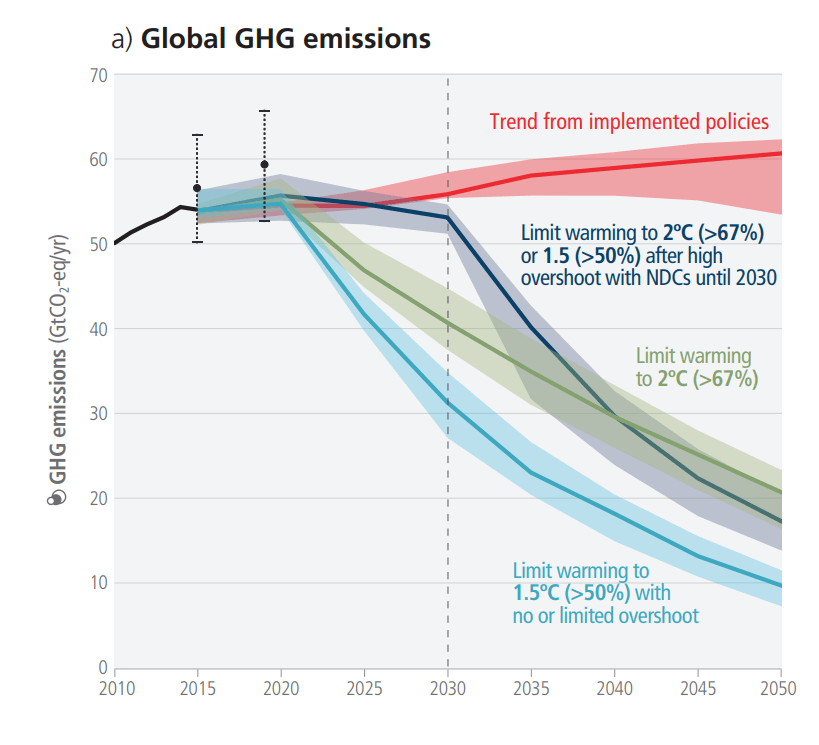Climate change is very important, threatening harm on a huge scale. However, there are many barriers to solving it, and it’s also less neglected than some other important problems. As such, climate change can be a promising cause area to work in, but it may be particularly important to find opportunities within it that are unusually tractable or neglected.
Read on to find out how we reached this conclusion.
What exactly is climate change?
Human behavior is causing the Earth to heat up. The climate has historically changed through a variety of causes, but for the last couple of centuries human behavior has driven shifts in the Earth’s climate at an unprecedented rate.
Through the release of greenhouse gasses from processes such as electricity production, agriculture, and industry (which contribute towards the greenhouse effect) the world has warmed by around 1°C of warming since the Industrial Revolution. Alarmingly, a 2023 report by the EU’s Copernicus Climate Change Service found that the previous eight years had been the eight warmest years ever recorded.
This warming is set to increase, causing a host of serious and widespread problems across the globe. These include more frequent extreme weather events such as heatwaves, hurricanes, and extreme rainfall, which in turn will likely lead to mass displacement, forest fires, flooding, and famines – among other issues. All of these threaten to cause harm and mortality on a huge scale, though the frequency and severity of these problems depend on how much climate change occurs.
This cause overview will look at climate change according to something called the ITN framework, which helps evaluate problems according to how important, tractable, and neglected they are. We use the ITN framework to prioritize global problems and work out where we might be able to do the most good – if you’re interested in why, or just want to better understand the framework, take a look at this relevant section in our career guide.
A note: This article was written in the second half of 2023. Because climate change is a quickly evolving space, some of our figures and conclusions could be out of date by the time you’re reading this.
How important is climate change?
As described above, climate change has and will continue to increase the frequency and severity of many risks, including heat stress, forced migration, poverty, water stress and droughts, natural disasters, food insecurity, and the spread of many diseases.
However, the extent to which these risks increase will depend on how well we’re able to mitigate the amount of climate change that occurs. An often-cited target is to keep warming to below 1.5°C above pre-industrial levels, something most of the world’s countries agreed to target in the 2015 Paris Agreement.
At 1.5°C of warming, we would avoid some of the worst effects of climate change, though the harm would still be huge. For instance, nearly 14% of the world’s population could experience severe heatwaves at least every five years, and millions more people could be exposed to severe droughts. Environmental damage and biodiversity loss will also occur, including damage to coral reefs, the vast majority of which may not even survive 1.5°C of warming.
However, it now looks likely that we’ll surpass 1.5°C relatively soon, despite these international targets. This makes higher levels of warming, and therefore increased harm, even more likely by the end of this century.
At 2°C of warming, for example, between 800 million and 3 billion people may suffer from chronic water scarcity, and nearly 200 million may experience severe droughts. Additionally, three times the number of people will experience severe heatwaves than they would at 1.5°C of warming. This amounts to an additional 1.7 billion people. Because of this, more people will likely die from heat-related causes.
Though these will be offset over the short term by a decrease in cold-related deaths due to colder regions becoming more temperate, climate change is likely to increase temperature-related deaths over the long run.
At higher levels, the picture looks even more extreme. At 3°C, we could see a five-times increase in extreme events relative to current levels by 2100 (as opposed to a four-fold increase at 1.5°C of warming), and at 4°C, up to four billion people will experience chronic water scarcity. This is one billion people more than would experience chronic water shortages at 2°C of warming. Other effects of climate change would also considerably ramp up as warming increases.
Fortunately, thanks to the work of climate activists who have increased the amount of global attention focused on climate change, we’ll likely avert some of these most severe projections. The IPCC’s 6th Assessment Report predicts that, even if we fail to undertake significant further action, it’s very unlikely that we’ll reach 3°C or more of warming.
Additionally, it bears noting that even with climate change’s negative effects on economic growth, the world’s GDP is still thankfully set to increase overall, creating better living standards for the majority of the world’s population.
Nonetheless, climate change threatens to make life worse for many than it otherwise would be – that is, counterfactually. Because of this, tackling climate change remains a very important challenge, and one which could save and improve many lives over the long run.
On top of this, there’s still lots of uncertainty over the precise effects of climate change, even at lower levels of warming. For instance, there remains a chance of severe climate effects caused by “tipping points” in which abrupt and irreversible changes to the climate can occur.
The most dangerous of these tipping points may only occur at higher temperatures not expected on our current trajectory, but their potential scale (and our uncertainty around them) makes them worth taking seriously nonetheless.
And regardless of the amount of warming we experience, the harms of climate change are set to disproportionately affect people and regions that are already worse off, exacerbating existing global inequalities.
On top of this, some are also concerned that the effects of climate change may indirectly exacerbate other large-scale risks, too – such as increasing the chance of international conflict via pressures induced by increased migration and resource scarcity. These considerations increase the importance of climate change beyond its direct effects.
So, as many people around the world have already recognized, climate change is an incredibly important global problem from a variety of considerations.
How tractable is climate change as a cause area?
Thanks to research and investment, as well as the efforts of environmental movements that have brought increased attention to climate change, we have seen some promising signs of progress that indicate a degree of tractability in tackling climate change.
For example, the price of renewable electricity has fallen precipitously in recent years, with the price of photovoltaic solar-powered electricity reducing by a massive 88% from 2010 – 2021, and the price of onshore wind and CSP (a different form of solar power) reducing by 68% in the same period.
Unfortunately, total greenhouse emissions are still increasing regardless. But we can already see some glimmers of hope in the fight against climate change; some regions, such as the United States and the European Union, have both been able to reduce their net emissions over the last decade – though only by fairly small amounts. So, though we need far more to be done, this shows that we can mitigate climate change, even while maintaining some of the benefits that our current infrastructure provides, such as economic growth.
And, though the climate is itself very complicated, we know how to mitigate climate change; we know both how to start reducing emissions now and also what kinds of research and technological development we’ll need to undertake to progress even further.
This challenge is still a significant one; there are still several political and financial barriers to ensuring that countries continue to decarbonize and take appropriate adaptation measures.
For instance, short election cycles can disincentivize politicians from paying short-term costs to prevent much larger long-term harms, as is needed on long-term issues like climate change. Furthermore, because mitigating climate change is a public good that provides global benefits, important actors like countries and large companies are incentivized to “free ride” on the efforts of others rather than take action themselves.
As we have seen over the past decades, these barriers are difficult to overcome.
It will likely also be difficult to reduce the rising emissions in high-population emerging economies such as China and India, which rely heavily on fossil fuels for energy production as they develop.
The bottom line is that climate change is a huge global challenge that lacks quick and easy solutions. However, the hard work of those working to fight climate change has already yielded promising results, and there remain several cost-effective interventions we might make.
Resource spotlight
Though there are no easy ways to solve climate change, some interventions would pay for themselves over the long run. An investigation by the World Bank found that many adaptation efforts, such as building climate-change-resilient infrastructure and improving water resource management, would ultimately save four times the money they cost to implement, amounting to trillions of dollars.
How neglected is climate change?
There’s room for much more action to address climate change. For instance, research by the Rockefeller Foundation suggests that global investment in climate finance needs to reach $3.4 trillion to reach net zero emissions. However, they estimate that global spending in 2020 was somewhere between $570 billion and $1.3 trillion (depending on what sort of funding we count), suggesting a substantial funding gap in climate change mitigation.
Furthermore, large discrepancies between international commitments and actual actions have led the IPCC to find it probable that we’ll exceed 1.5°C of global warming in the 21st century, despite a widespread global consensus to try and limit warming below 1.5°C.

Similar gaps appear to exist regarding climate change adaptation, with the same IPCC report also concluding that there are ‘widening disparities between the estimated costs of adaptation and the finance allocated to adaptation.’ The report specifically points out that Africa’s adaptation spending is billions of dollars below needed levels.
Having said this, climate change receives fairly significant amounts of resources and attention – especially when compared to other cause areas you might choose to work on, including other global catastrophic risks. With hundreds of billions spent per year, and prominent political parties committed to climate action in many countries, climate change is now a mainstream issue.
In an important sense, this is great news – much of the world has recognized the importance of climate change and there is, to a large extent, financial and political impetus to address it. Clearly, this hasn’t translated into as much action as we’d like to see, but there are grounds for some cautious optimism.
But because of this good news, it’s likely more challenging to make a big difference in climate change as an individual. Climate change is now a relatively crowded area, with lots of people and organizations working within it. This means that if you decide to work in this area, it’s particularly important to strategically choose specific problems and solutions within climate change that are more neglected than others.
Why might you not prioritize climate change?
Perhaps the main reason you might choose to prioritize a different global problem is related to the discussion in the previous section – that some other important cause areas are even more neglected than climate change in terms of resources such as time, money, policy, and political attention that are devoted to them.
This is important because of an effect called diminishing returns – whereby the more time, effort, or resources you direct toward solving a problem, the less impact each additional investment is likely to have. Diminishing returns doesn’t always apply, but we think it’s likely to apply in many cases when we’re trying to have a positive social impact. It’s plausible that – all else being equal – it’s easier to make a bigger marginal difference in more neglected cause areas than in climate change.
Another reason is that it can be difficult to observe the impact you make in climate change. Because combating climate change incurs effects that diffuse over wide areas and long timespans, you won’t be able to directly see the people you’re helping – some might find this dynamic makes it difficult to maintain motivation.
It can also be difficult to know if you’re having a positive impact at all within some climate change paths. For example, it’s often very difficult to trace policy decisions and other important events back to specific actions, so if you’re working to influence important decisions, you might never really know how helpful your efforts were.
What can you do about climate change?
Despite some of these challenges, working to address climate change can be a very valuable way to spend your time.
One way you might be able to help is through individual consumption choices such as what you eat and wear, or how you travel. Some of these actions (for example, taking fewer long-haul flights) can make a significant relative reduction in your contributions to climate change.
But the absolute difference you can make through better consumption decisions is, in many cases, surprisingly modest. For instance, recycling comprehensively for a year will save an estimated 210kg of CO2 emissions – this might sound like a lot, but you’d be able to achieve the same impact by donating just a few dollars towards carbon offsetting, at least according to one estimate from Giving Green – a climate-focused charity evaluator.
In contrast, the difference you could make with your career is often surprisingly high – that is, if you’re able to perform great work in the most high-priority problems within climate change, and can find a relevant career that’s a great fit for you, you could end up making a very meaningful difference.
For instance, imagine helping to shape your entire country’s climate policy as a civil servant or climate scientist, developing novel technologies that reduce the use of fossil fuels, or being an influential advocate for neglected climate solutions like nuclear energy. These are difficult achievements to reach, but people in these positions can potentially reduce hundreds of millions of tons of greenhouse gas emissions, or help prevent many thousands of people from climate-change-related harms.
Recommended resources for taking action
Fellowships and internships
Here are a few great recurring opportunities for those who are interested in climate change careers, and are early-career or still studying:
- The UN lists multiple climate change internship opportunities primarily for advanced undergraduates and postgraduates in a range of disciplines.
- The UK’s Environment Agency offers an annual academic internship in their Chief Scientist’s Group, as well as a Summer internship for people from minority ethnic backgrounds.
- Last Energy’s annual Climate Fellowship provides an opportunity to work on clean energy technology, including engineering and policy work.
Communities
Effective Environmentalism runs a LinkedIn group and a Facebook group for people interested in taking cost-effective action to solve climate change.
Online courses
These are courses that have been recommended to us by experts, or look like particularly good ways to upskill within climate change:
- Harvard’s free course on the health effects of climate change dives deeper into some of the problems we discuss in this article.
- For those not yet studying climate science, the University of Chicago runs a free introductory course on the science of climate change, with a further course on creating climate models.
You can also explore
- Our article on the top priorities within climate change
- AR6 Synthesis Report: Climate Change 2023 – Intergovernmental Panel on Climate Change
- Climate Change Cause Report – Founder’s Pledge
- CO₂ and Greenhouse Gas Emissions – Our World in Data
- Interview with Johannes Ackva on Effective Climate Interventions – 80,000 Hours

